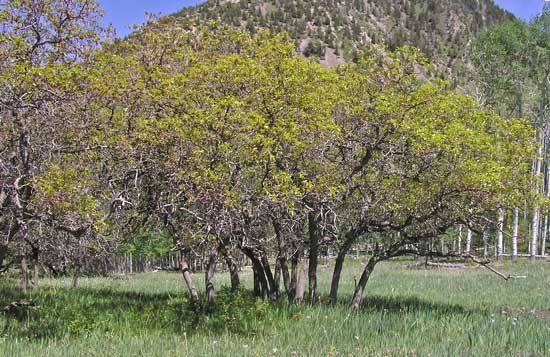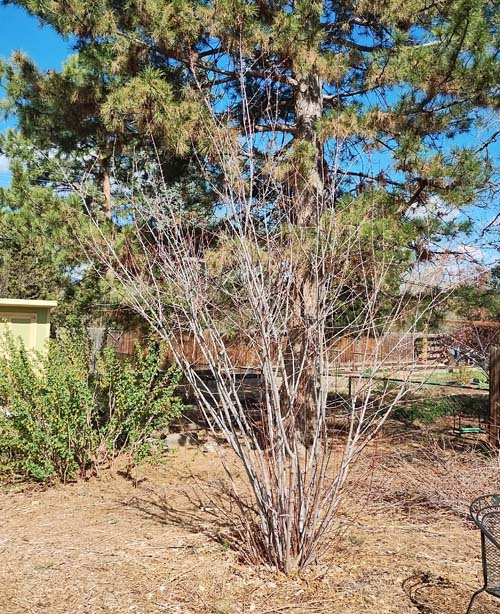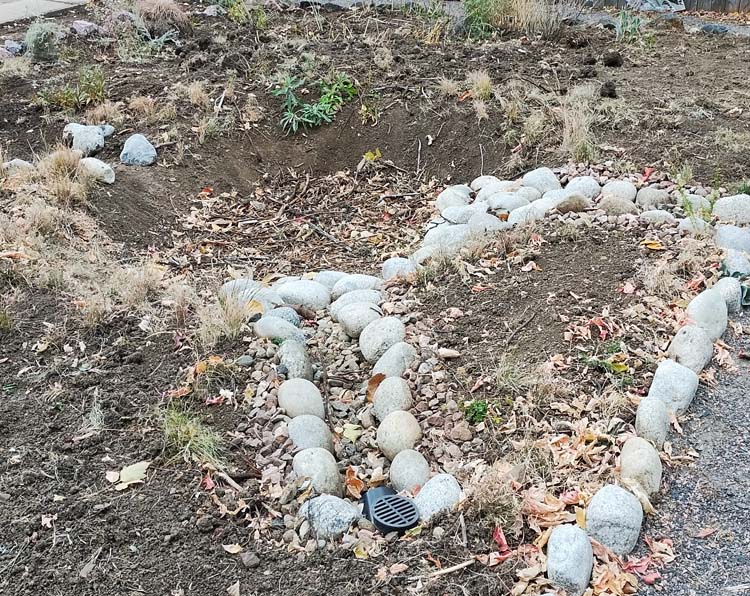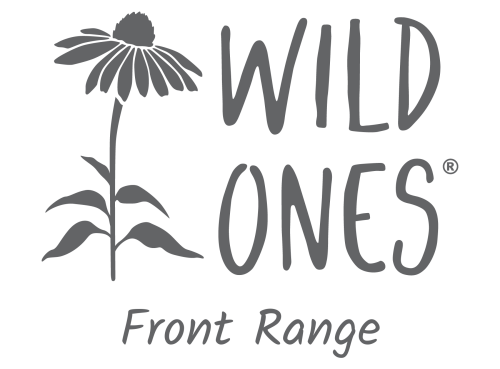By Paul Alaback and Kristine Johnson
Why Use Multi-Stemmed Trees?
When we think of creating a native garden or landscape in the semi-arid West, we often conjure up an image of a dry prairie with many wildflowers and grasses, all adapted to hot dry conditions. While some places were historically prairie, all around Colorado we find streams, canyons, foothills or other geological or topographic features that include wetlands, riparian areas, shrublands, forests or woodlands. While these places with woody plants could sometimes occupy less than 10 percent of the landscape, in many cases they provided habitat for 70 percent or more of the bird species! If we want to use nature as a model for how to build our landscapes, then we might want to consider the value of adding woody species to our gardening projects that go beyond the typical large shade trees. This is especially important if a key aim is to create habitat for a wide number of bird and insect species.
Douglas Tallamy in his popular books and lectures has laid out why it is so important to create not just pleasant and aesthetically pleasing landscapes but to create habitat, making a significant contribution to helping maintain biodiversity, even in urban and suburban areas. Tallamy’s examples often focus on the humid deciduous forests in the eastern and midwestern US, where an astounding diversity of insects and birds can be found. However, many of the principles he lays out can apply to our drier landscapes, including the overwhelming value of woody plants for insects and birds.

Bird and insect diversity is profoundly influenced by the number of layers of vegetation in an ecosystem. Think of rainforests with layer upon layer of vegetation from the ground to the top of a canopy. Each of these canopy layers has differences in humidity, temperature, wind, and chemical or physical characteristics of leaves, twigs, and branches. All these factors create a mosaic of habitats for insects, and all the animals that depend on them like birds. So, by creating more canopy layers, we provide more diverse habitats, which is what you see in many native habitats that include shrubbier vegetation.
Willows deserve special mention. Often neglected in projects aiming to increase habitat for pollinators, willows are in fact key species for pollinators in many ecosystems. They provide prodigious amounts of early season pollen. Willows also host many species of plant-eating insects and their predators, in part due to their leaves having diverse chemistry and a good source of nutrients. Patches of willows and cottonwoods along streams or seeps are considered “biodiversity hotspots” in the western US due to the rich diversity in insects, birds and other wildlife that they typically support. If you have a moist place in your yard, they can add a lot of habitat value to your yard. The Xerces Society for example highly recommends one of our native willows, the pussy willow (Salix discolor) for its habitat value for pollinators. Coyote willow (S. exigua) is also considered a keystone species for insects.
Here we want to highlight one group of woody plants that is key to creating this diversity but is often neglected in native plant gardens: multi-stemmed trees and large shrubs. These plants cafit in smaller urban and suburban spaces, add layers to your landscape, and provide many ecosystem services to both wildlife and people.
What are Multi-Stemmed Trees and Large Shrubs?

We include deciduous small trees and large shrubs of multi-stemmed trees and shrubs, mostly but not all riparian. We focus on plants at least 6-to-10 feet in height, no taller than 25 feet at maturity. They do not have one central leader (stem or trunk); they can be “thicket forming” or “suckering.” This leads to good habitat for wildlife and good screening for privacy and wind. Our eyes have been trained to prefer large shade trees with a single trunk, but sited and cared for properly (ie, not improperly or overly pruned), these plants have a place in our gardens. In general, they are found in the following genera that are highly supporting:
- Pollinators (NWF): Prunus, Salix, Quercus, Betula, Alnus, Acer, Crataegus, Corylus, Amelanchier
- Birds (Audubon): Prunus, Corylus, Sorbus, Lonicera, Ribes, Sambucus, Acer, Amelanchier, Salix, Shepherdia, Rhus, Betula
Where/How?
Many of the species on this list are available at nurseries but often are not used in landscapes; some of them have attractive features such as flowers, berries, and/or fall color, and all have high habitat value to pollinators, a wide range of insects in general, and/or birds. Many of them can support 200 or more species of caterpillars, which are a key food source for birds. Some (particularly riparian) need extra thought about placement and culture; they should be placed in low or wet spots in yards or along ditches; they may need shade from taller trees or the north side of buildings, and/or they benefit from being placed in rain gardens with adequate mulching to create a moist soil sponge that supports them through the heat of summer. (Consider exploring the work of Brad Lancaster.) Thicket forming/suckering plants can be directed and cared for; choose the right space and know how to care for them. They can be planted along chain link fences to create screening hedgerows, and if they have a linear space in which to spread they could also be planted in a semi shady narrow side yard. They can provide some cooling through shade and evapotranspiration to the western walls of any home while being appropriately sized for the space.
Support Riparian Species with a Rain Garden

The push to conserve water in our landscapes by moving away from lush lawns and thirsty non-native ornamental plants protects ecosystems, but careful and deliberate direction of precipitation can support more water-intensive native plants of high habitat value in our yards. For example, the creation of rain (and snow!) harvesting “basins,” fed by runoff from roofs and hard surfaces can double (or more) the water that falls from the sky. When such garden basins are well-mulched with organic matter, a “soil sponge” is created which will absorb and hold water for plants without creating anoxic conditions which kill plants and support mosquitos. For more information, seek out books, podcasts, and webinars featuring Brad Lancaster as well as the resources available at the Watershed Management Group in Tucson, AZ.
- Moist/or riparian species: need places with shade or moisture (understory, rain garden, north sides, higher elevations); rain gardens. (Kristine has a rain garden with the two Acers, the Sambucus, Alnus, and would like to add Corylus; Betula on the north side with special mulching.)
- Or… hedgerow (multiple selections are more xeric and tend to form thickets): for privacy screening along property lines, to break up wind. (Kristine has a chain link fence along two sides and didn’t want to put in wooden privacy fences. Instead, she has Robinia, Quercus, the two Prunus, Forestiera, Shepherdia; would like to add Crataegus and keep filling in.)
Multi-Stemmed Native Woody Plants
(Water use, according to CSU Extension publications or personal estimation-?)
Soapberry Family (Sapindacae)
- Big-toothed maple (Acer grandidentatum) (L-M)
- Rocky Mountain maple (Acer glabrum) (L-M)
Birch Family (Betulaceae)
- Thinleaf alder (Alnus tenuifolia) (H)
- Western water birch (Betula occidentalis) (H)
- Beaked hazelnut (Corylus cornuta) (M-H?)
Rose Family (Rosaceae)
- Western serviceberry (Amelanchier alnifolia) (L-M)
- Fleshy hawthorn (Crataegus succulenta) (M?)
- American wild plum (Prunus americana) (L-M)
- Pin-cherry (Prunus pennsylvanica) (M?)
- Chokecherry (Prunus virginiana) (M)
- Mountain ash (Sorbus scopulina) (M)
Beech Family (Fagacae)
- Gambel oak (Quercus gambelii) (L-M)
- Gray oak (Quercus grisea),(L-M?)
- Sonoran scrub oak (Quercus turbinella) (L-M?)
Willow Family (Salicacae)
- Pussy willow (Salix discolor) (M-H?)
- Coyote willow (Salix exigua)* (M-H?)
- Bluestem willow (Salix irrorata) (M-H?)
Sumac Family (Anacardaceae)
Smooth sumac (Rhus glabra) (L-M)
Honeysuckle Family (Caprifoliaceae)
Twinberry (Lonicera involucrata) (M)?
Gooseberry Family (Grossulaceae)
Golden currant (Ribes aureum) (M?)
Moschlatel Family (Adoxaceae)
Red elderberry (Sambucus racemosum) (M-H?)
er
Desert olive (Forestiera pubescens var. neomexicana) (L)
Hoptree (Ptelea trifoliata) (M-H)
New Mexico locust (Robinia neomexicana) (L-M)
Silver buffaloberry (Shepherdia argentea) (L-M)
Sources
https://extension.colostate.edu/topic-areas/yard-garden/native-shrubs-for-colorado-landscapes-7-422/
https://rockies.audubon.org/habitat-hero/resources
https://www.nwf.org/Native-Plant-Habitats/Plant-Native/Why-Native/Keystone-Plants-by-Ecoregion
Books available from Boulder Bookstore, Colorado Native Plant Society or online bookstores.
Douglas Tallamy. 2019. Nature’s Best Hope: A New Approach to Conservation That Starts in Your Yard.
Gwen Kittel. 2024. Willows of Colorado, ecology and identification.
Jack Carter. 2006. Trees and Shrubs of Colorado.
